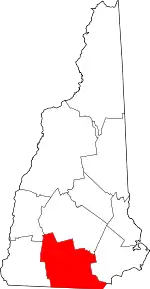Hillsborough, New Hampshire
Hillsborough, frequently spelled Hillsboro, is a town in Hillsborough County, New Hampshire, United States. The population was 6,011 at the 2010 census.[3] The town is home to Fox State Forest and part of Low State Forest.
Hillsborough, New Hampshire | |
|---|---|
Town | |
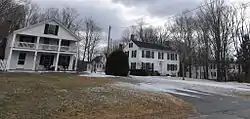 Houses in historic Hillsborough Center | |
 Seal | |
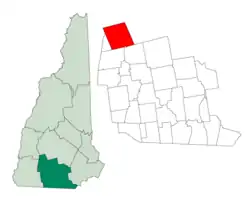 Location in Hillsborough County, New Hampshire | |
| Coordinates: 43°06′53″N 71°53′42″W | |
| Country | United States |
| State | New Hampshire |
| County | Hillsborough |
| Incorporated | 1772 |
| Villages | Hillsborough Hillsborough Center Hillsborough Lower Village Hillsborough Upper Village Emerald Lake Village |
| Government | |
| • Board of Selectmen | James C. Bailey III John P. Stohrer Dave J. Rogers[1] |
| • Town Administrator | Laura Buono[2] |
| Area | |
| • Total | 44.6 sq mi (115.6 km2) |
| • Land | 43.6 sq mi (113.0 km2) |
| • Water | 1.0 sq mi (2.6 km2) 2.23% |
| Elevation | 636 ft (194 m) |
| Population (2010) | |
| • Total | 6,011 |
| • Density | 138/sq mi (53.2/km2) |
| Time zone | UTC-5 (Eastern) |
| • Summer (DST) | UTC-4 (Eastern) |
| ZIP code | 03244 |
| Area code(s) | 603 |
| FIPS code | 33-36180 |
| GNIS feature ID | 0873625 |
| Website | www |
The main village of the town, where 1,976 people resided at the 2010 census,[4] is defined as the Hillsborough census-designated place (CDP), and encompasses the main urban area of the town, located along the Contoocook River at the junction of New Hampshire Route 149 with Henniker Street and Main Street. The town also includes the villages of Hillsborough Center, Hillsborough Upper Village, Hillsborough Lower Village, and Emerald Lake Village.
History
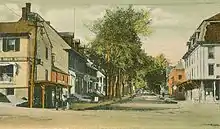
The town was first granted in 1735 by colonial governor of Massachusetts and New Hampshire Jonathan Belcher as "Number Seven", one in a line of nine Massachusetts towns set up as defense barriers against Indian attacks. The towns were renamed after the border between the two provinces was fixed in 1739, placing the towns in New Hampshire. Settled in 1741, the town was granted in 1748 by Governor Benning Wentworth as "Hillsborough", named for Sir Wills Hill, Earl of Hillsborough.[5] It would be incorporated in 1772 by Governor John Wentworth.
Hillsborough was the birthplace of Franklin Pierce, the 14th president of the United States and the only president from New Hampshire. The Pierce Homestead was built in 1804 (the year of his birth) by his father, Benjamin Pierce, a general in the Revolutionary War, and twice governor of New Hampshire. Restored in 1925, the home was designated a National Historic Landmark in 1961. Listed on the National Register of Historic Places, the house is today a museum owned by the state, and operated by the Hillsborough Historical Society.
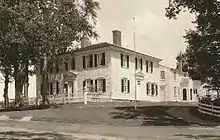
Five granite arch bridges built during the 19th century in Hillsborough are designated as National Historic Civil Engineering Landmarks.
Railroad service was supplied to Hillsborough by the Boston and Maine Railroad from 1878 to 1972. Rail service north to Henniker had ceased in 1942, and Hillsborough became the end point on a line that once stretched in an arc from Nashua to Concord, New Hampshire. The rails in Hillsborough were torn up in 1979. Hillsborough was once home to an iconic railroad covered bridge and a curved wooden trestle. The bridge burned due to arson in 1985, and the trestle was dismantled shortly thereafter. The Hillsborough Branch now ends at Bennington; the line from Bennington to Hillsborough is a rail trail.
Geography
According to the United States Census Bureau, the town has a total area of 44.6 square miles (115.6 km2), of which 43.6 sq mi (113.0 km2) is land and 1.0 sq mi (2.6 km2) is water, comprising 2.23% of the town.[3] The town center, or census-designated place, has a total area of 1.6 sq mi (4.2 km2).[4]
The highest point in Hillsborough is Thompson Hill, at 1,768 feet (539 m) above sea level, in the northern part of town. Hillsborough is drained by the Contoocook River, in addition to Beard's and Sand brooks. Part of Franklin Pierce Lake is in the southwest. The town lies fully within the Merrimack River watershed.[6]
Adjacent municipalities
- Bradford, New Hampshire (north)
- Henniker, New Hampshire (east)
- Deering, New Hampshire (southeast)
- Antrim, New Hampshire (south)
- Windsor, New Hampshire (west)
- Washington, New Hampshire (northwest)
Demographics
| Historical population | |||
|---|---|---|---|
| Census | Pop. | %± | |
| 1790 | 798 | — | |
| 1800 | 1,311 | 64.3% | |
| 1810 | 1,592 | 21.4% | |
| 1820 | 1,982 | 24.5% | |
| 1830 | 1,792 | −9.6% | |
| 1840 | 1,808 | 0.9% | |
| 1850 | 1,685 | −6.8% | |
| 1860 | 1,623 | −3.7% | |
| 1870 | 1,595 | −1.7% | |
| 1880 | 1,646 | 3.2% | |
| 1890 | 2,120 | 28.8% | |
| 1900 | 2,254 | 6.3% | |
| 1910 | 2,168 | −3.8% | |
| 1920 | 2,229 | 2.8% | |
| 1930 | 2,160 | −3.1% | |
| 1940 | 2,269 | 5.0% | |
| 1950 | 2,179 | −4.0% | |
| 1960 | 2,310 | 6.0% | |
| 1970 | 2,775 | 20.1% | |
| 1980 | 3,437 | 23.9% | |
| 1990 | 4,498 | 30.9% | |
| 2000 | 4,928 | 9.6% | |
| 2010 | 6,011 | 22.0% | |
| 2017 (est.) | 5,945 | [7] | −1.1% |
| U.S. Decennial Census[8] | |||
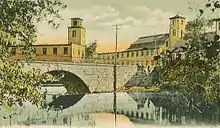
As of the census of 2010, there were 6,011 people, 2,392 households, and 1,614 families residing in the town. The population density was 137.9 people per square mile (53.2/km2). There were 2,896 housing units at an average density of 66.4 per square mile (25.6/km2). The racial makeup of the town was 96.4% White, 0.6% Black or African American, 0.3% Native American, 0.6% Asian, 0.03% Native Hawaiian or other Pacific Islander, 0.3% some other race, and 1.8% from two or more races. Hispanic or Latino of any race were 1.4% of the population.[9]
There were 2,392 households, out of which 34.2% had children under the age of 18 living with them, 50.2% were headed by married couples living together, 11.6% had a female householder with no husband present, and 32.5% were non-families. 24.5% of all households were made up of individuals, and 8.5% were someone living alone who was 65 years of age or older. The average household size was 2.51, and the average family size was 2.98.[9]
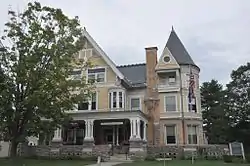
In the town, the population was spread out, with 24.8% under the age of 18, 7.4% from 18 to 24, 27.1% from 25 to 44, 29.8% from 45 to 64, and 11.0% who were 65 years of age or older. The median age was 38.6 years. For every 100 females, there were 98.9 males. For every 100 females age 18 and over, there were 95.3 males.[9]
For the period 2007–2011, the estimated median annual income for a household in the town was $54,386, and the median income for a family was $67,621. Male full-time workers had a median income of $43,583 versus $32,030 for females. The per capita income for the town was $23,232. About 7.1% of families and 11.2% of the population were below the poverty line, including 8.5% of those under age 18 and 6.5% of those age 65 or over.[10]
Education
Hillsborough is part of School Administrative Unit (SAU) 34. Public schools serving the community of Hillsboro include:
- Hillsboro-Deering Elementary School
- Hillsboro-Deering Middle School
- Hillsboro-Deering High School
Sites of interest
- Contoocook Mills Industrial District
- DAR Museum Room, in the Fuller Public Library
- Five Stone Arch Bridges
- Franklin Pierce Homestead (1804)
- Railroad Bridge (1903-1985)
- Union Chapel (1887)
Notable people
- Christopher Columbus Andrews, soldier, diplomat, newspaperman, author, and forester
- David Bailey, abolitionist on Lincoln legal case Cromwell vs. Bailey and militia officer in the Black Hawk War[11]
- Wilson Bethel, actor
- James Frankland Briggs, politician
- Benjamin Pierce Cheney, a founder of American Express
- Scott Drapeau, basketball player
- James Hill, member of the Wisconsin State Assembly and the Wisconsin State Senate
- Benjamin Franklin Keith, vaudeville theater owner
- Timothy G. O'Connell, architect
- Benjamin Pierce, governor of New Hampshire, father of Franklin Pierce
- Benjamin Kendrick Pierce, United States Army officer, son of Benjamin Pierce and brother of Franklin Pierce
- Franklin Pierce, 14th President of the United States
- John Butler Smith, manufacturer and the 44th governor of New Hampshire
- Gertrude Bass Warner, art collector, pioneer of museum studies
References
- "Board of Selectmen". Retrieved March 11, 2020.
- "Town Administration". Retrieved April 21, 2019.
- "Geographic Identifiers: 2010 Demographic Profile Data (G001): Hillsborough town, Hillsborough County, New Hampshire". U.S. Census Bureau, American Factfinder. Archived from the original on February 12, 2020. Retrieved February 7, 2013.
- "Geographic Identifiers: 2010 Demographic Profile Data (G001): Hillsborough CDP, New Hampshire". U.S. Census Bureau, American Factfinder. Archived from the original on February 12, 2020. Retrieved February 7, 2013.
- Browne, George Waldo (1921). The History of Hillsborough, New Hampshire, 1735-1921, Volume 1: History and Description. Published by the town. p. 88.
- Foster, Debra H.; Batorfalvy, Tatianna N.; Medalie, Laura (1995). Water Use in New Hampshire: An Activities Guide for Teachers. U.S. Department of the Interior and U.S. Geological Survey.
- "Annual Estimates of the Resident Population: April 1, 2010 to July 1, 2017 (PEPANNRES): Minor Civil Divisions – New Hampshire". Archived from the original on February 13, 2020. Retrieved November 15, 2018.
- "Census of Population and Housing". Census.gov. Retrieved June 4, 2016.
- "Profile of General Population and Housing Characteristics: 2010 Demographic Profile Data (DP-1): Hillsborough town, Hillsborough County, New Hampshire". U.S. Census Bureau, American Factfinder. Archived from the original on February 12, 2020. Retrieved February 7, 2013.
- "Selected Economic Characteristics: 2007–2011 American Community Survey 5-Year Estimates (DP03): Hillsborough town, Hillsborough County, New Hampshire". U.S. Census Bureau, American Factfinder. Archived from the original on February 12, 2020. Retrieved February 7, 2013.
- Moore, William F. and Jane Anne, Collaborators for Emancipation: Abraham Lincoln and Owen Lovejoy, pg. 53
External links
| Wikivoyage has a travel guide for Hillsborough, New Hampshire. |
- Town of Hillsborough official website
- Hillsborough Chamber of Commerce
- New Hampshire Economic and Labor Market Information Bureau Profile
- Fuller Public Library
